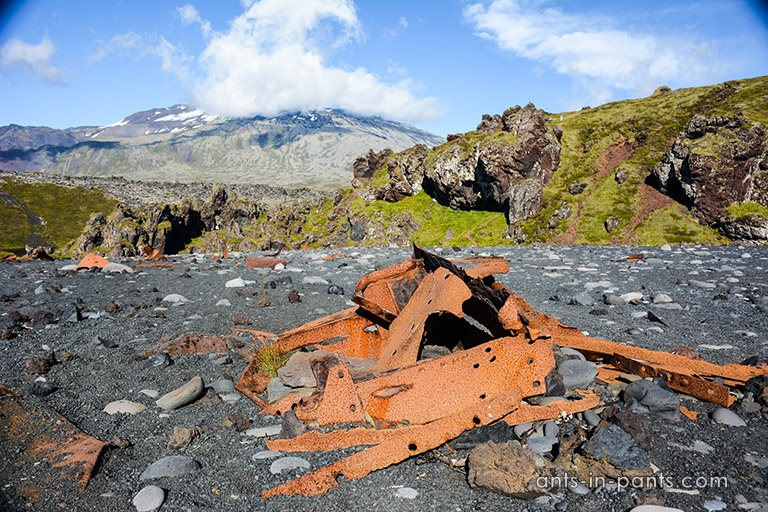While most of people coming to Iceland try to make a circle around the island using the main road №1, we decided to concentrate on several particular regions instead, some of them less visited. Among them is Snæfellsnes peninsula in the West part of Iceland, much less crowded compared to the more popular destination, yet, not less fun! You can make a circle in one day and save some more time next morning too to see the Shark museum!


Eldborg crater is one of the most symmetrical and beautiful craters in Iceland. You may choose to ascend it (2.5 hours walk) or watch the volcano which has last erupted 50000-60000 years ago from below.

A long wall of basalt columns is at Gerðuberg. You can easily see it from route 54, but we recommend you take a detour to see it up close. Some columns are 3 meters high.

At this point of your trip in Iceland, you give up taking pictures of the waterfalls: there are too many of them.

On this road you will see a lot of lava, though without moss unlike the route to the east of Vik.

Yutri tunga beach
Yutri tunga beach is a well-known seal colony, and this became our favourite place in Snæfellsnes peninsula. Here you can see two Icelandic seal species. The harbor seal is most common in Icelandic waters, but also everywhere in the world. They are very social and often stick in groups. The grey seal is much bigger than the harbor seal, they are more shy and prefer to keep away from the shore.
At first we were watching the seals from very far. Can you find one on the picture? Well, they are actually here, and this picture was taken on a 10xzoom.

Hunting the seals for pictures is a demanding work.
Yet, then we found another spot with lots of seals and watched them for about two hours, totally mesmerized.




After sometime we started to notice that seals are actually drowning on their stones, covered with water more and more. The water level was rising.

When we turned back we realized that the water rose so high that it separated us from the land. This is how we had to go back.

Be smarter than we are and make sure that you have extra clothes for the change: this is essential for Iceland in general.
As everywhere in Iceland, make sure that you come early to avoid people and tide.
After this cold bath we decided we need a warmer alternative. On the way, we found hot baths and fully enjoyed them. Lýsuhólslaug is open 13.00-20.30 and is taken very good care of. You understand what you pay for (about 10 euros), and they also offer tea, coffee, and very nice facilities. It is not overcrowded unlike many other baths.


Búðakirkja church is something really impressive. It was first built in 1703 and then demolished, and again rebuilt. It is protected as one of the oldest wooden churches in Iceland.


This locality was also the place of living of the most famous serial killer in Icelandic history. Axlar-Björn lived here in the 16th century and often hosted travelers who enjoyed his hospitality as the region’s first known farm holiday provider. Björn stretched his income by killing travellers with an axe and stealing their belongings. Hei s believed to have murdered 18 people, although he only confessed killing 9. He was sentenced to death and excecuted in 1596.

Arnartsapi, the ancient fishing station and the current holiday area showcases really beautiful settings at the foot of the glacier. It takes about an hour to stroll along its shore and enjoy the views. Unique cliffs of the coast make it the protected area.


The sculpture of Bárður guardian spirit of Snæfellsnes peninsula was erected here in 1989.

In Arnatsapi and around, you may often see Snæfellsjökull glacier dominating the skyline of Snæfellsnes. It makes the major part of Snæfellsnes National Park rising 1446 meters above the sea level. It is one of the seven Energy centers of the Earth and has mystical properties akin to those at Mt. Shasta and the Giza Pyramid.

Dritvik
The next stop Dritvik offers a lot of diversity of landscapes in front of Snæfellsjökull Glacier as well as a cozy beach.



It has a beautiful and relaxing beach which was a place of shipwreck in 1948 and still contains a lot of ship remains in it. They were once part of the British trawler, five of the crew of 19 were saved. Rescue teams from the nearby villages came to help, but conditions were difficult, with bad weather and heavy seas.

These stones were used to check if a fisherman qualifies for the job. The larger stone he could lift – the better. Now tourists may also try. They are 23, 54, 100 and 154 kilos each.

Ingjaldsholl church provides more beautiful views in front of Snæfellsjökull.

We suggest that you finish your day in Kirkjufel – the most photographed mountain in Iceland with small Kirkjufelfoss waterfall nearby.


There is a very basic, yet, nice camping next to it protected from the peninsula winds from all the sides.

It is possible that you will not be able to see one more important attraction on this day – the Shark Museum at Snæfellsnes peninsula is definitely worth a visit and you may want to save it for the morning.




No Comments